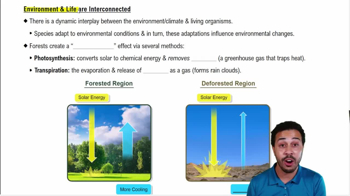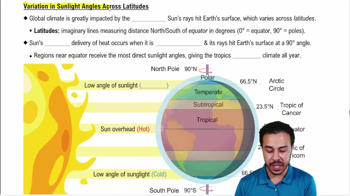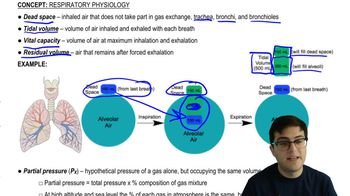Table of contents
- 1. Introduction to Biology2h 42m
- 2. Chemistry3h 40m
- 3. Water1h 26m
- 4. Biomolecules2h 23m
- 5. Cell Components2h 26m
- 6. The Membrane2h 31m
- 7. Energy and Metabolism2h 0m
- 8. Respiration2h 40m
- 9. Photosynthesis2h 49m
- 10. Cell Signaling59m
- 11. Cell Division2h 47m
- 12. Meiosis2h 0m
- 13. Mendelian Genetics4h 44m
- Introduction to Mendel's Experiments7m
- Genotype vs. Phenotype17m
- Punnett Squares13m
- Mendel's Experiments26m
- Mendel's Laws18m
- Monohybrid Crosses19m
- Test Crosses14m
- Dihybrid Crosses20m
- Punnett Square Probability26m
- Incomplete Dominance vs. Codominance20m
- Epistasis7m
- Non-Mendelian Genetics12m
- Pedigrees6m
- Autosomal Inheritance21m
- Sex-Linked Inheritance43m
- X-Inactivation9m
- 14. DNA Synthesis2h 27m
- 15. Gene Expression3h 20m
- 16. Regulation of Expression3h 31m
- Introduction to Regulation of Gene Expression13m
- Prokaryotic Gene Regulation via Operons27m
- The Lac Operon21m
- Glucose's Impact on Lac Operon25m
- The Trp Operon20m
- Review of the Lac Operon & Trp Operon11m
- Introduction to Eukaryotic Gene Regulation9m
- Eukaryotic Chromatin Modifications16m
- Eukaryotic Transcriptional Control22m
- Eukaryotic Post-Transcriptional Regulation28m
- Eukaryotic Post-Translational Regulation13m
- 17. Viruses37m
- 18. Biotechnology2h 58m
- 19. Genomics17m
- 20. Development1h 5m
- 21. Evolution3h 1m
- 22. Evolution of Populations3h 53m
- 23. Speciation1h 37m
- 24. History of Life on Earth2h 6m
- 25. Phylogeny2h 31m
- 26. Prokaryotes4h 59m
- 27. Protists1h 12m
- 28. Plants1h 22m
- 29. Fungi36m
- 30. Overview of Animals34m
- 31. Invertebrates1h 2m
- 32. Vertebrates50m
- 33. Plant Anatomy1h 3m
- 34. Vascular Plant Transport1h 2m
- 35. Soil37m
- 36. Plant Reproduction47m
- 37. Plant Sensation and Response1h 9m
- 38. Animal Form and Function1h 19m
- 39. Digestive System1h 10m
- 40. Circulatory System1h 49m
- 41. Immune System1h 12m
- 42. Osmoregulation and Excretion50m
- 43. Endocrine System1h 4m
- 44. Animal Reproduction1h 2m
- 45. Nervous System1h 55m
- 46. Sensory Systems46m
- 47. Muscle Systems23m
- 48. Ecology3h 11m
- Introduction to Ecology20m
- Biogeography14m
- Earth's Climate Patterns50m
- Introduction to Terrestrial Biomes10m
- Terrestrial Biomes: Near Equator13m
- Terrestrial Biomes: Temperate Regions10m
- Terrestrial Biomes: Northern Regions15m
- Introduction to Aquatic Biomes27m
- Freshwater Aquatic Biomes14m
- Marine Aquatic Biomes13m
- 49. Animal Behavior28m
- 50. Population Ecology3h 41m
- Introduction to Population Ecology28m
- Population Sampling Methods23m
- Life History12m
- Population Demography17m
- Factors Limiting Population Growth14m
- Introduction to Population Growth Models22m
- Linear Population Growth6m
- Exponential Population Growth29m
- Logistic Population Growth32m
- r/K Selection10m
- The Human Population22m
- 51. Community Ecology2h 46m
- Introduction to Community Ecology2m
- Introduction to Community Interactions9m
- Community Interactions: Competition (-/-)38m
- Community Interactions: Exploitation (+/-)23m
- Community Interactions: Mutualism (+/+) & Commensalism (+/0)9m
- Community Structure35m
- Community Dynamics26m
- Geographic Impact on Communities21m
- 52. Ecosystems2h 36m
- 53. Conservation Biology24m
48. Ecology
Introduction to Ecology
Problem 4
Textbook Question
Areas of low solar irradiation are
a. Closer to the equator than to the poles
b. Closer to the poles than the equator
c. At high altitudes
d. Close to large bodies of water
e. More than one of the above is correct
 Verified step by step guidance
Verified step by step guidance1
Understand the concept of solar irradiation: Solar irradiation refers to the amount of solar energy received per unit area. It is influenced by factors such as latitude, altitude, and proximity to water bodies.
Recall the relationship between latitude and solar irradiation: Areas closer to the equator receive higher solar irradiation due to the direct angle of sunlight, while areas closer to the poles receive lower solar irradiation because sunlight strikes at a more oblique angle.
Consider the effect of altitude: High-altitude areas can receive more solar irradiation because the atmosphere is thinner, reducing the scattering and absorption of sunlight. However, this is not directly related to low solar irradiation.
Evaluate the role of large bodies of water: Proximity to large bodies of water can moderate temperatures but does not significantly affect the amount of solar irradiation received.
Analyze the options: Based on the above points, identify which option(s) correctly describe areas of low solar irradiation. Focus on latitude (closer to the poles) and eliminate options that do not align with the concept of solar irradiation.
 Verified video answer for a similar problem:
Verified video answer for a similar problem:This video solution was recommended by our tutors as helpful for the problem above
Video duration:
2mPlay a video:
Was this helpful?
Key Concepts
Here are the essential concepts you must grasp in order to answer the question correctly.
Solar Irradiation
Solar irradiation refers to the power of solar radiation received per unit area, typically measured in watts per square meter. It varies significantly across the Earth's surface due to factors such as latitude, season, and atmospheric conditions. Areas closer to the equator generally receive more direct sunlight year-round, while regions near the poles receive less due to the angle of sunlight incidence.
Recommended video:
Guided course

Environment & Life are Interconnected
Latitude and Climate
Latitude is a geographic coordinate that specifies the north-south position of a point on the Earth's surface. It plays a crucial role in determining climate patterns, including temperature and solar energy distribution. Regions at higher latitudes (closer to the poles) typically experience lower temperatures and reduced solar irradiation compared to those near the equator.
Recommended video:
Guided course

Variation in Sunlight Angles Across Latitudes
Altitude and Solar Exposure
Altitude, or elevation above sea level, can influence solar exposure and temperature. Higher altitudes often experience cooler temperatures and can have varying solar irradiation levels depending on geographic location. However, in some cases, high-altitude areas may receive more direct sunlight due to thinner atmosphere, but this does not necessarily correlate with overall solar energy availability compared to lower latitudes.
Recommended video:
Guided course

Air Movement and Partial Pressure
Related Videos
Related Practice
Textbook Question
Add labels to the figure that follows, which illustrates how various factors influence local climate.
878
views


